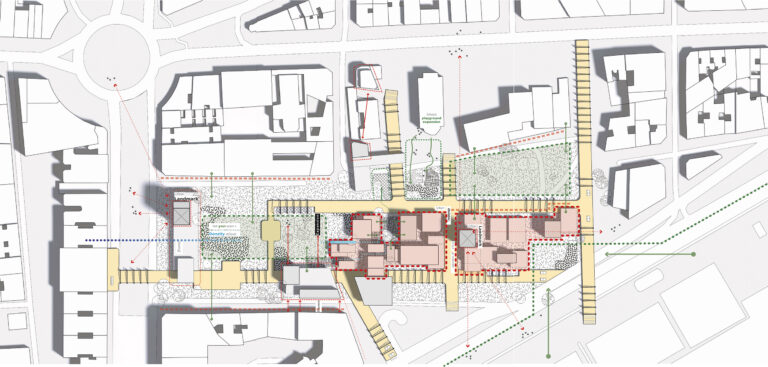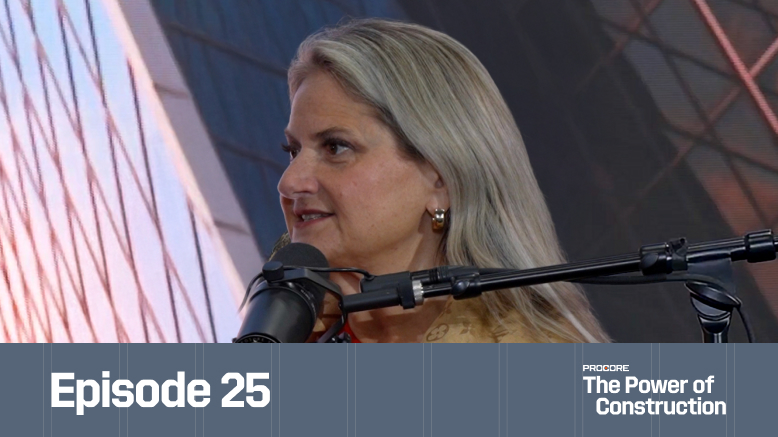— 8 min read
How Construction Mapping Transforms Site Management


Last Updated Sep 23, 2025

Makenna Ryan
Civil & Infrastructure Solutions Engineer
Makenna Ryan is a Solutions Engineer at Procore. Prior to joining Procore, he spent seven years at McDermott International Inc. as a construction Manager and Senior Equipment Engineer. He also spent three years as a Project Engineer at Subsea7. Makenna received his B.S. in Mechanical Engineering and Technology from Texas Tech University. He is based in the Houston area.

Trey Strange
Contributing Writer
27 articles
Trey Strange is a Peabody and Emmy-Award winning writer and producer based in Brooklyn, NY. Throughout his career, Trey has worked for the Huffington Post, Houston Chronicle, Out Magazine, Brooklyn Eagle, CNBC, INTO, and New York Magazine's Bedford + Bowery. He received his Masters in Journalism and Middle East studies from New York University, and Bachelors in the same subjects from the University of Houston.
Last Updated Sep 23, 2025

Gone are the days when construction teams relied solely on paper maps and manual sketches. Today, advanced digital tools are revolutionizing how construction sites are visualized and managed. With the rise of construction mapping, detailed and dynamic representations of jobsites improve accuracy but and help streamline complex project execution — setting the stage for a new era in construction.
Construction mapping refers to the process of creating site maps using advanced technologies. It often means using drones and 3D scanning to capture real-time data from the construction site.
Mapping helps coordinate logistics, allocate resources and track a project’s advancement toward closeout. With detailed site maps, project managers can make informed decisions about where to place materials, how to manage crews and how to track progress over time.
This article explores the unique benefits and challenges of construction mapping, including its evolution over time, potential costs and training requirements and ways this tool can lead to better margins.
Table of contents
Evolution of Mapping in Construction
Being able to visualize a construction site before it’s built has long been necessary in the field. Since the introduction of Geographic Information Systems (GIS), crew members have had access to survey-driven data and digitally accessible maps to inform their decisions.
Today, the field is embracing the sophisticated technologies of drone mapping and 3D scanning. The scanning process captures the shape and features of an environment, often using lasers emitted from a scanning device, which can be mounted on a drone. The laser bounces back to the device from the surface being scanned. After collecting all of the data points from the environment, the scanner builds a complete 3D model of the space.
I met with a company that’s building the new high-speed rail between L.A. and Las Vegas, the Bright Line Rail Project. It’s super cool, and going to be cutting edge when it finishes — but right now, the job site is literally the open desert. They currently have all the maps printed on paper and pinned to the walls, so better mapping tools will be critical for this team.
We need to get a grip on, where do I put materials? How do I get people out there? What are my logistics to move materials, equipment, labor? Where am I actually supposed to put this railroad? There are no reference points that we have in other projects. And so this mapping component is really important to these really big, horizontal and infrastructure jobs.

Makenna Ryan
Civil & Infrastructure Solutions Engineer
Procore
Practical Benefits of Construction Mapping
One of mapping technology’s biggest benefits is improved accuracy in utility coordination. With mapping, teams can easily identify where existing utility lines and hook-ups are located—both reducing guesswork and making sure that any excavation doesn't accidentally damage these utilities.
Another advantage is enhanced production tracking and material measurement. With detailed maps, construction managers can keep track of where materials are, how much is available and how quickly they’re being used. Coordinating the site this way also helps reduce the risk of accidents—and mapping can also help identify potential hazards before they become a problem.
How we park and move equipment around where we put materials, the logistics and the flow of a job site, is massively important. Mapping helps to think through some of that. It helps me think through where to put materials and where not to — because in six weeks, I may need to bring in a crane, and that material’s not going to be gone yet. When we can visualize these things before they happen and see the future state of the site, it gives us that ability to really manage the space and think things through.
Makenna Ryan
Civil & Infrastructure Solutions Engineer
Procore
Mapping can significantly improve progress tracking and the management of deliverables. Using regularly updated data, teams can easily see what’s been completed and what’s still left to do.
One of the most incredible uses of mapping is for volume measurement. For example, software can analyze a picture or model of a stockpile of materials and estimate how much is in the pile. As another example, it could measure the volume of dirt excavated, which could be useful for precise progress tracking.
Mapping Technology and Tools
A general contractor (GC) needs to be aware of different technologies in order to make the most out of mapping processes.
Two major file types exist for GIS data: ArcGIS and KML. ArcGIS is popularly used by governments, meaning public sector data is likely going to be stored in this file type. It also requires a little more technical knowledge to implement correctly than data stored as a KML file, which is the information stored in applications like Google Earth.
Having a working and efficient construction software that can successfully implement these files into a project’s database is a necessity for using mapping. The easier the software is to use, the more quickly teams can adopt it and begin seeing benefits.
A GC will also need mapping software, like DroneDeploy, which allows users to create aerial maps and 3D models from scans—and can perform calculations to measure volumes of stockpiles or materials.
Challenges of Construction Mapping
One of the greatest obstacles for most construction companies in implementing mapping solutions is cost. Investing in drones and software can be expensive and may have ongoing costs for maintenance and subscriptions.
Setting up these systems and training team members to use them is another time-consuming cost of mapping — especially if the company isn’t the most tech-savvy already. It’s often necessary to appoint a team or point person to move the company toward mapping technologies.
Having somebody on your team who’s going to take ownership of mapping implementation is the biggest hurdle. It’s a new technology, which means it can be tough to get into. On top of that, someone’s also going to have to figure out how to fly the drone.”
It’s important to note that the Federal Aviation Administration (FAA) regulates airspace—a detail that GCs who’ve worked in airport construction will be well aware of—and flying a drone commercially generally involves a licensing exam. And just like performing construction outdoors, operating a drone outside can be complex and subject to weather conditions.
Makenna Ryan
Civil & Infrastructure Solutions Engineer
Procore
Best Practices for Implementing Construction Mapping
Despite challenges, construction mapping can greatly benefit many projects—especially when integrated in an efficient management software program.
Following a few best practices can also help with a smooth transition.
Start small.
Figure out what aspect of mapping the construction company can most benefit from and work on implementing processes for this aspect first.
I think the first question to ask is, what problem are you trying to solve? There's a lot of different ways to tackle mapping and a lot of different technologies out there. Is it measuring bulk material that's a big pain for you? Is it production tracking? Is it tracking equipment? Find a mapping solution geared toward your needs.
Makenna Ryan
Civil & Infrastructure Solutions Engineer
Procore
Appoint a champion for mapping.
The most successful GC is able to delegate tasks to confident and capable team members. Appointing someone to spearhead the initial processes and do the research to make sure the software and technology the company is purchasing are the right tools can help with buy-in as well as implementation.
The right person to take ownership for this process within the company will be willing, interested in moving the company’s technology forward and trustworthy.
Focus on what’s best for return on investment (ROI).
Capturing key data points that can help with decision-making can help maximize ROI in the long run.
For example, mapping can help construction teams to accurately measure the amount of materials stored on-site. This precise data can allow companies to most accurately bill clients for materials used in a project. When a GC knows how much material is on-hand and how much has been used, they can create accurate bids and billing statements, leading to better margins and increased profits.
In this way, mapping can reduce the risk of eating into profits by under-billing.
The Future of Mapping in Construction
Mapping is likely to become more widely adopted and its tool will probably become more user-friendly.
We're starting to see mapping tie into larger systems of data collection. There's an Internet of Things (IoT) component here that’s mostly going undiscussed and unrealized. The potential for integrating live data from sensors into our mapping tools could completely change how we operate and manage projects."
Makenna Ryan
Civil & Infrastructure Solutions Engineer
Procore
IoT refers to a network of physical devices connected to the internet, collecting and sharing data. In construction, IoT devices can include sensors on equipment and building materials that provide real-time data about their conditions and performance. For example, sensors could send instant updates about equipment locations or environmental conditions, helping teams off-site or far-off make quick, informed decisions.
This continuous mapping would create what’s called a “digital twin,” or real-time virtual model, of the worksite. In practice, teams could use this model to test changes and see their impacts before breaking ground on them, saving both time and resources.
Free AI in Construction Course with Hugh Seaton
Start learning today with industry expert Hugh Seaton and discover how AI can boost efficiency, reduce risk, and transform your projects.

Buying into Construction Mapping Technology
The future of mapping is exciting and full of possibilities, and buying in on training and developing mapping techniques now will likely help companies evolve with the technology.
For now, companies can adopt mapping practices in the ways that may benefit them most — and reap the rewards of near-automated progress tracking and material storage, accurate billing and improved margins.
Was this article helpful?
Thank you for your submission.
100%
0%
You voted that this article was . Was this a mistake? If so, change your vote
Scroll less, learn more about construction.
Subscribe to The Blueprint, Procore’s construction newsletter, to get content from industry experts delivered straight to your inbox.
By clicking this button, you agree to our Privacy Notice and Terms of Service.
Thank you!
You’re signed up to receive The Blueprint newsletter from Procore. You can unsubscribe at any time.
Categories:
Written by

Makenna Ryan
Civil & Infrastructure Solutions Engineer | Procore
Makenna Ryan is a Solutions Engineer at Procore. Prior to joining Procore, he spent seven years at McDermott International Inc. as a construction Manager and Senior Equipment Engineer. He also spent three years as a Project Engineer at Subsea7. Makenna received his B.S. in Mechanical Engineering and Technology from Texas Tech University. He is based in the Houston area.
View profile
Trey Strange
Contributing Writer
27 articles
Trey Strange is a Peabody and Emmy-Award winning writer and producer based in Brooklyn, NY. Throughout his career, Trey has worked for the Huffington Post, Houston Chronicle, Out Magazine, Brooklyn Eagle, CNBC, INTO, and New York Magazine's Bedford + Bowery. He received his Masters in Journalism and Middle East studies from New York University, and Bachelors in the same subjects from the University of Houston.
View profileExplore more helpful resources

Who is accountable for innovation in construction?
Everyone says construction needs to innovate—but no one agrees on who’s actually responsible for making it happen. Is it the owner? The builders? The tech vendor? Or is innovation everyone’s...

What Drives Better Safety Outcomes—Carrot, Stick, or “Zero Harm”?
On paper, construction has never looked safer. In reality, mental health claims are rising, workers are disengaged and the compliance playbook is broken. Garry Mansfield, co-founder of Scratchie, argues the...

Is the Tech Stack Construction’s Most Powerful Talent Strategy?
Construction doesn’t need more tech for tech’s sake—it needs tech that helps people build. In this episode, Dustin Burns, SVP of Technology & Business Solutions at McCownGordon, shares how relying...

How Close Are We to Bridging the Design-Build Divide?
For decades, construction decisions have often been made based on gut instinct. But what if the real barrier to transformation isn’t technology—it’s the divide between design and construction? In episode...
Free Tools
Calculators
Use our calculators to estimate the cost of construction materials for your next project.
Templates
Find a template to help you with your construction project tasks.
Material Price Tracker
Get the latest U.S. retail prices and view historical trends for common building materials.
Glossary
Explore key terms and phrases used in the industry.
